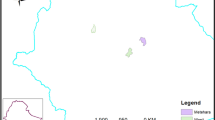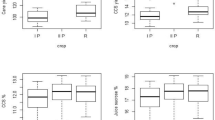Abstract
Increasing selection efficiency in un-replicated populations has remained a challenge to sugarcane breeders due to the effects of genotype by environment interaction and competition among plots. Therefore studies aimed at exploring models to improve selection efficiency are required. At the South African Sugarcane Research Institute, the Stage II selection populations are planted to un-replicated plots. Visual selection, which is known to be subjective, is used to determine the genotypes advanced. Although path coefficient analysis has identified important yield components, there is little use of that knowledge to enhance selection. This study demonstrates the use of logistic regression model as a statistical decision support tool to enhance selection in un-replicated populations. The logistic regression model used stalk number, stalk height, stalk diameter and estimable recoverable crystal (ERC) % cane to predict sugar yield. The data were collected from Stage II populations across regional breeding programs and analysed using the logistic procedure of Statistical Analysis System. The Likelihood Ratio, Score and Wald statistics were highly significant (P < 0.0001) indicating the robustness of the models. Stalk number is the most influential component to sugar yield followed by diameter, height and ERC % cane. The coefficients of the yield components varied across different programs indicating the potential of the analysis to determine yield component combination. Genotypes selected using the models produced significantly higher trait values than those rejected. The logistic regression models should enhance selection efficiency in un-replicated populations as well as provide for the evaluation of breeding populations and trait combinations across regional breeding programs.


Similar content being viewed by others
References
Agresti A (2007) An introduction to categorical data analysis, 2nd edn. Wiley, New York
Allison PD (2003) Logistic regression using the SAS system: theory and applications. SAS Institute Inc., Cary
Bouchez A, Goffinet B (1989) Evaluation of selection index: application to the choice of an indirect multi-trait selection index for soybean breeding. Theor Appl Genet 29:261–267
Bowie DK (2006) Using multivariate logistic regression analysis to predict black male persistence at a predominantly white institution: an approach investigating the relationship between student engagement and persistence. PhD Dissertation, Louisiana State University
Casella G, Berger RL (2003) Statistical Inference, 2nd edn. Thomson publications, USA
Chang YS, Milligan SB (1992) Estimating the potential of sugarcane families to produce elite genotypes using univariate cross prediction methods. Theor Appl Genet 84:662–671
Coetzee NA, Brunkhorst MJ (2000) Potential methods of improving the detection of promising sugarcane clones in early selection trials. Proc SASTA 74:238–244
Cohen JE (2006) Public opinion in state politics. Stanford University Press, Palo Alto
Cox MC, Stringer JK (1998) Efficacy of early generation selection in a sugarcane improvement program. Proc ASSCT 20:148–153
De Sousa-Vieira O, Milligan SB (1999) Intra-row spacing and family x environment effects on sugarcane family evaluation. Crop Sci 39:358–364
De Sousa-Vieira O, Milligan SB (2005) Interrelationships of cane yield components and their utility in sugarcane family selection. Interciencia 30(2):93–96
Elgin JH, Hill RR, Zeiders KE (1970) Comparison of four methods of multiple traits selection for five traits in alfalfa. Crop Sci 10:190–193
Falconer DS, Mackay TFC (1996) Introduction to quantitative genetics, 4th edn. Longman Group Ltd, London
Gravois KA, Milligan SB, Martin FA (1991) Indirect selection for increased sucrose yield in early sugarcane testing stages. Field Crops Res 26:67–73
Hazel LM, Dickerson GE, Freeman AE (1993) The selection index—then, now and for the future. J Dairy Sci 77:3236–3251
Hogarth DM, Berding N (2006) Breeding for a better industry: conventional breeding. Sugarcane Int 24(2):26–31
Hosmer DW, Lemeshow S (1989) Applied logistic regression. Wiley, New York
Jackson PA, McRae TA (1998) Gains from selection of broadly adapted and specifically adapted sugarcane families. Field Crops Res 59:151–162
Jackson PA, McRae TA (2001) Selection of sugarcane clones in small plots: effects of plot size and selection criteria. Crop Sci 41:315–322
Kang MS (1994) Applied quantitative genetics. Louisiana State University, Baton Rouge
Kang MS, Miller JD, Tai PYP (1983) Genetic and phenotypic path analysis and heritability in sugarcane. Crop Sci 23:643–647
Kang MS, Sosa O, Miller JD (1989) Path analysis for percent fiber, and cane and sugar yield in sugarcane. Crop Sci 29:1481–1483
Kimbeng CA, Cox MC (2003) Early generation selection of sugarcane families and clones in Australia: a review. J Am Soc Sugarcane Technol 23:20–39
Le CT (1998) Applied categorical data analysis. Wiley, New York
Manning HL (1956) Yield improvement from a selection index technique with cotton. Heredity 10:303–322
McRae TA, Jackson PA (1998) Competition effects in selection trials. Proc ASST 20:154–161
Miller JD, James NI (1974) The influence of stalk density on cane yield. Proc ISSCT 15:177–184
Milligan SB, Gravois KA, Bischoff KP, Martin FA (1990) Crop effects on genetic relationships among sugarcane traits. Crop Sci 30:927–931
Robinson HF, Comstock RE, Harvey PH (1951) Genotypic and phenotypic correlations in corn and their implications in selection. Agron J 43:282–287
SAS Institute (2009) The SAS System for Windows Version 9.1.3. SAS Institute, Cary
Shaw MEA (1982) Aspects of variety improvement. Proc Inter Am Sugar Cane Semin 3:106–114
Shoonees-Muir BM, Ronaldson MA, Naidoo G, Schorn PM (2009) SASTA Laboratory Manual including the Official Methods. SASTA, South Africa
Simlote KM (1947) An application of discriminant function for selection in durum wheats. Indian J Agric Sci 17:269–280
Singh RK, Singh SP, Singh SB (2005) Correlation and path analysis in sugarcane ratoon. Sugar Tech 7(4):176–178
Skinner JC, Hogarth DM, Wu KK (1987) Selection methods, criteria and indices. In: Heinz DJ (ed) Sugarcane improvement through breeding. Elsevier, Amsterdam, pp 409–453
Stringer JK, Cullis BR (2002a) Application of spatial analysis techniques to adjust for fertility trends and identify interplot competition in early sugarcane selection trials. Aust J Agric Res 53:911–918
Stringer JK, Cullis BR (2002b) Joint modeling of spatial variability and interplot competition. In McComb JA (ed) Plant Breeding for the 11th Millenium. Proceedings of the 12th Australian Plant Breeding Conference, Perth, W. Australia, 15–20 September 2002: 614–619
Subandi W, Compton A, Empig LT (1973) Comparison of the efficiencies of selection indices for three traits in two variety crosses of corn. Crop Sci 13:184–186
Zhou M (1998) Trends in yield, sucrose, stalk population and smut tolerance over 20 years of sugarcane selection in Zimbabwe. Proc SASTA 72:47–50
Zhou M (2004) Stalk population control of yield, quality and agronomic traits of sugarcane population in early selection stages. Sugar Cane Int 22(5):14–20
Acknowledgments
To staff at SASRI research stations for assistance with management of trials and data collection.
Author information
Authors and Affiliations
Corresponding author
Appendix 1
Appendix 1
SAS Code for analyzing the selection predictions
proc Logistic data = one Descending covout outest = KSL11;
model Select = Stalks Height Diameter ERC;
output out = predict p = ph_hat lower = LCL upper = UCL;
run;
Proc print data = predict; run;
Proc print data = KSL11; run;
Rights and permissions
About this article
Cite this article
Zhou, M. Using logistic regression models for selection in non-replicated sugarcane breeding populations. Euphytica 191, 415–428 (2013). https://doi.org/10.1007/s10681-013-0899-x
Received:
Accepted:
Published:
Issue Date:
DOI: https://doi.org/10.1007/s10681-013-0899-x




